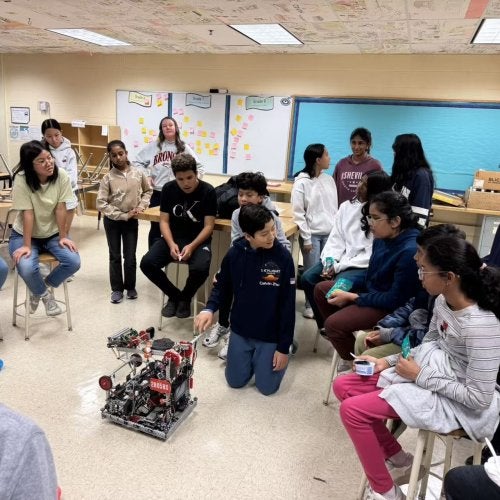
The Maryland Initiative for Literacy and Equity (MILE), a partnership between the University of Maryland and Morgan State University, released key findings and recommendations from their comprehensive review of literacy instruction in public school districts across the state. With the ultimate goal of helping every Maryland student read and write proficiently, MILE focused their recommendations on literacy curriculum and instruction, professional development for teachers and administrators, tailored support for students with differing needs and engagement with families and communities.
Commissioned by the Maryland State Department of Education (MSDE), MILE’s report was presented to the State Board of Education on Sept. 23 following a monthslong review of literacy instruction in all 24 public school districts. It’s part of the state’s implementation of the Blueprint for Maryland’s Future, a $3.8 billion, 10-year investment in public education spanning prekindergarten to postsecondary education.
“This report represents the most extensive review of early literacy instruction that has ever been conducted in the state and potentially the country. To be able to partner with the state and work alongside our local districts to understand their successes and challenges will have a profound impact on our schools and children,” said Donald J. Bolger, MILE director and associate professor in UMD’s College of Education. He leads the initiative along with Co-director Simone Gibson Ph.D. ’09, associate professor at Morgan State University, and Executive Director Maggie Polizos Peterson Ph.D. ’14, associate clinical professor in UMD’s College of Education.
In spring 2024, the MILE team visited 86 public elementary schools and observed instructional practices in nearly 500 classrooms. They conducted focus groups and interviews of 863 elementary teachers, principals and staff and surveyed 1,650 educators. After MILE reviewed each district’s preK-5 literacy plan and provided initial feedback, the districts made revisions and resubmitted their plans for additional guidance. In August, MILE shared individualized reports with each district, recognizing current strengths and issuing recommendations to help them improve literacy instruction.
“A comprehensive statewide review of literacy instruction is a critical step in achieving the goals of the Blueprint. It ensures that all students receive high-quality, equitable, research-based literacy instruction,” said Tenette Smith, executive director of literacy programs and initiatives at MSDE. “It sets the stage for their long-term academic and career successes, and it will help Maryland close learning gaps that exist between students from varying backgrounds.”
MILE, which was initially funded by a UMD Grand Challenges grant, continues its work as English language arts (ELA) scores in the annual Maryland Comprehensive Assessment Program begin to rebound from the pandemic. Only 48.4% of Maryland students across all grades were proficient in ELA in the standardized tests administered last spring, up from 47.9% in 2023.
The scores, released in August, also revealed significant proficiency gaps among student groups. ELA proficiency for all tests combined ranged from 31.8% for Hispanic/Latino students to 74.8% for Asian students. Multilingual students, economically disadvantaged students and students with disabilities had much lower proficiency rates compared to the overall student population.
Supported by a $958,000 grant from MSDE, the MILE team hired 13 literacy expert reviewers and 13 research associates for its review, and worked with partners at the AIM Institute for Learning and Research and Antonio Fierro, a national expert in early literacy, to develop tools and rubrics for data collection. The reviewers found that nearly all districts have provided training to deepen primary teachers’ (K-3) understanding of the science of how children learn to read. They also found that teachers in intermediate (4-5) and secondary classrooms need this knowledge to support their struggling learners. “The kids in fourth, fifth and sixth grades are the ones who experienced the greatest disruption in learning to read during the pandemic,” said Bolger.
Teachers across the state reported benefiting the most from in-school intervention support and coaching, particularly on foundational skills such as phonics, vocabulary and explicit writing instruction.
The report also calls for a heavier focus on intermediary literacy skills and a boost in support for diverse learners, including more access to culturally relevant materials and supports for multilingual learners as well as for effective communication with underserved communities.
“There is a misunderstanding of what is culturally responsive,” Gibson said. “There is an assumption that you can only be culturally responsive if you are working with poor Black children that is inappropriate. We all have cultures that we can engage in.”
In addition, the team recommended increased instructional coaching for teachers and leadership training for administrators, and enhanced guidance to help teachers collect and use data to identify students who are struggling with reading and then work to meet their individual needs.
“This is a supportive, not an evaluative process,” said Smith. “We're here to help [the districts] improve on their efforts to support students as well as teachers.”
According to Smith, MSDE reached out to MILE to conduct the review because of the initiative’s focus on both literacy and equity and because the team had already established strong relationships with school districts across the state.
Other takeaways from its report:
- With CARES Act funding ending, districts are struggling to provide the same level of coaching and intervention support that has been crucial to their recent success. New funding obtained by MSDE through the U.S. Department of Education's Comprehensive Literacy State Development Program and additional philanthropic partnerships should provide some needed relief.
- School districts with the most effective literacy plans adopt high-quality instructional materials, provide professional development that connects the science of how children learn to classroom practices, build strong cultures of literacy leadership, and engage with families in inclusive and culturally relevant ways.
- Many districts are working to achieve seamless literacy development as students progress from grades K-2 to grades 3-5.
- Teachers entering into the profession from both alternative certification pathways and traditional teacher-prep programs need additional training on the complex landscape of literacy and learning to read.
- All districts are engaging families and communities in their literacy efforts, but the extent of this engagement often relies on the availability of additional school-level funding.
Maryland State Board of Education President Joshua Michael praised the MILE team as the state’s “leading teacher prep faculty,” stressing their contributions to aligning teacher preparation programs with the Science of Reading. “You are setting the pace for what true partnership looks like, what scholar-practitioners look like across the state.”
Photo by iStock


